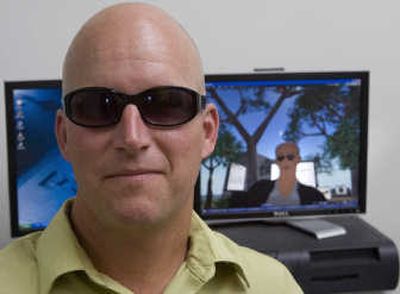Education island

Washington State University bookkeepers scratched their heads this spring when David Cillay submitted an invoice, for about $50, for an island. It was awhile before they learned he was buying land in “Second Life,” the online immersive virtual world where WSU has begun offering courses for students from across the globe.
Cillay, an assistant dean for distance education at the Pullman campus, launched WSU’s first full-fledged course in “Second Life” this spring. The graduate-level course in instructional design had seven education program students logging on and communicating with one another over the Internet.
In “Second Life,” people choose an avatar – a physical representation of themselves – with a distinct name. For Cillay, the name became Cdpe Voom. Cdpe is the acronym for Center for Distance and Professional Education.
To be a resident in “Second Life,” users adopt a mode of dress and select how their avatar looks – tall, thin, large, bewhiskered, shaggy-maned, bald or buff. In “Second Life,” no one looks like a dork.
For Cillay and the class, this was a test of how to develop new ways for classroom interaction. While “Second Life” has a large number of education institutions testing the waters, Cillay’s was the first formal effort by WSU to use the online site as a virtual classroom.
Once inside “Second Life,” users can move through a detailed and imaginatively rendered 3-D world of buildings, lands and shopping districts. The higher education subculture in “Second Life” is among the most experimental, with many schools offering both traditional courses and experiments in sharing and collaborating.
Other area schools, such as the University of Idaho, have also tested the “Second Life” waters.
Cillay said the main result has been discovering that the students enjoyed the ability to gather, even if the session was nothing more than pixels on a screen. Even though they were using avatars as representations, the students exchanged comments through voice or text messaging.
In this “Second Life” version, the seven students could all log onto “Second Life” and interact with Cillay and one another. Cillay noticed people who previously had not used “Second Life” took to the 3-D world naturally.
Cillay’s class would start with the students joining him at the WSU Island surrounded by a body of water. They’d gather there in a grove of trees where they could place themselves in virtual lounge chairs arranged outside in a semicircle.
Among their first assignments was a discussion about what “instructional design” means – the concept of developing and testing new ways of reaching students.
As part of the experiment, Cillay also led the class on “Second Life” field trips. They visited a virtual nuclear power plant created by a Colorado university, and another school that created a construction lab that tested how much weight a building could withstand before collapsing.
Cillay said he will offer a second version of the instructional design course in “Second Life” this fall. Another plan is to use “Second Life” to build a virtual WSU student center, he said. “It would be just like having a student center on campus, but in “Second Life,”” he said.
Cillay also offers three recommendations for educators thinking of using virtual environments:
“Temper your expectations. “There’s a tremendous wow factor for people just discovering ‘Second Life,’ ” he said. Students need some time to adjust and learn how to move and operate in that world.
“”Understand what your expectations are,” Cillay said. Rather than expect huge gains in a classroom environment, consider it a first step in educational experimentation.
“Give yourself and the students time to explore. “Do some research ahead of time, so you know the environment and find out what other educators are doing there,” said Cillay.
Howard Gardner, the WSU vice president in charge of economic development and extension programs, said “Second Life” is best seen as a step in the development of new ways to reach students.
“The end will not be ‘Second Life,’ ” Gardner said. “It’s a different way to reach people and engage them effectively.”